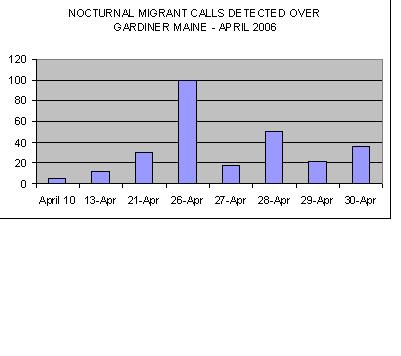May 1, 2006
Since the beginning of April, I've been recording nocturnal bird calls on most good migration nights at my home in Maine. I have a microphone built based on the specifications available at night flight call guru Bill Evan's website (www.oldbird.org).
I set the microphone in a deck chair on my porch, facing up into the sky and run the microphone cord under my front door and to the kitchen table. The cord is plugged into a small Rolls pre-amp and from there into my laptop. I have running on the laptop, two automatic call detection programs that Bill provides for free at his Old Bird website. Each time the microphone 'hears' a sound that is in the right frequency range for a bird call, the program saves the sound in a file with the date and time.
My son calls it the bird answering machine.
In the morning I can quickly go through the sounds that have been saved from the night before thanks to yet another free program from Bill called Glassofire. I throw out the sounds of drips, clicks, car horns, and the occasional conversation of passersby and save the bird calls.
It�s incredibly fun and a little addictive to check through each night�s registry of calls to hear what passed over. My biggest night migration flight was the night of April 26-27 when I registered over a hundred calls. An American Bittern went over at 11:41 that night, announcing its presence with a low, gruff 'Aark'. Eleven Hermit Thrushes winged north through the dark between 11:00 and 12:30, each giving their mournful whistle as they passed over my house. Since mid-April, my listening station has detected at least 50 of these thrushes. Virginia Rails have gone over on several nights as have Killdeer and Great Blue Herons.
Listen to my recordings of these species by clicking below:
American Bittern
Hermit Thrush
Virginia Rail
Killdeer
Great Blue Heron
The largest numbers of birds in the last two weeks especially have been sparrows and warblers. White-throated Sparrows show up in particular abundance--not unexpected since their total population is estimated at 140 million, over 80% of which migrate north to the Boreal to breed. I�ve picked up quite a few of what I�m pretty sure are Savannah Sparrows and Chipping Sparrows too.
Yellow-rumped Warblers are the warbler species that I seem to be getting in most abundance so far but with a sprinkling of what I think are Palm Warblers and a few others, perhaps Pine Warblers.
To hear some of my recordings of these species click below:
White-throated Sparrow
Savannah Sparrow
Chipping Sparrow
Yellow-rumped Warbler
Palm Warbler
This year, in celebration of International Migratory Bird Day and its Boreal Bird theme, we at the Boreal Songbird Initiative are teaming up with Audubon to host two Nocturnal Migration Concert events in May. On the evenings of May 19th at Prospect Park in Brooklyn and May 20th at the Audubon center in Greenwich, Connecticut, we will have a nocturnal bird microphone set up with the sounds piped into the auditorium sound system to eavesdrop into the calls spilling down from the Great Bird Current heading north to the Boreal. If you are from New York City or Connecticut, consider joining us!
 |

